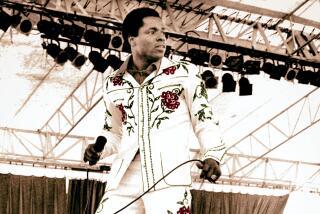Review: Into the ether with Greil Marcus’ ’ History of Rock ‘n’ Roll’
“Once a song has gone into the ether, it never disappears,” Greil Marcus remarks in “The History of Rock ‘n’ Roll in Ten Songs.” But it never reappears in quite the same form, either. A song like “Money (That’s What I Want)” means something entirely different when sung by Barrett Strong in 1960 as it does when sung by John Lennon in 1963 (or the Flying Lizards in 1979, for that matter).
Unlike many rock critics, who tend to fetishize the details of specific recordings, Marcus is interested in songs with multiple versions and variations, songs with more than one story to tell. More than any other music writer, Marcus has insisted on this folkloric approach to pop criticism, in which one song, or performance, leads to another. For him, “rock ‘n’ roll may be more than anything a continuum of associations, a drama of direct and spectral connections between songs and performers.”
Marcus is best known for writing about the music of the 1960s and ‘70s, Bob Dylan and punk being his wheelhouses. (His writing on Dylan was recently collected into a 512-page volume that spans 1968-2010.) But “The History of Rock ‘n’ Roll” mostly avoids these comfort zones in favor of the late ‘50s, when the music was first coming together.
“The sound in early rock ‘n’ roll records, especially group harmony singles, often has a preternatural clarity at its heart,” Marcus writes. “You are there, watching, hoping, as the song unfolds, that no one breaks the spell.” There are meditations on the Five Satins’ “In the Still of the Nite,” Etta James’ “All I Could Do Was Cry,” Buddy Holly’s “Crying, Waiting, Hoping,” Strong’s “Money,” the Drifters’ “This Magic Moment” and the Teddy Bears’ (with Phil Spector) “To Know Him Is to Love Him.” These songs are all standards, and to anyone raised within demographic spitting distance of the baby boom, probably a little overfamiliar. Marcus’ ambition, as usual, is to reclaim their strangeness and explain their staying power.
There’s a touch of nostalgia to this project that’s new for Marcus. He has always availed himself of autobiography (his long-running column, currently appearing in the Believer, is called Real Life Rock Top Ten, the “real life” in question being his own), but here he allows his critical eye to get a little mistier than usual. “You had to listen to everything on the market and try to understand what wasn’t there — and what wasn’t there was you,” he writes of his teenage years. In time, these personal experiences become myths.
“[T]he Oldies But Goodies album carried a queer sensation,” he writes of a 1979 compilation, “that of feeling your own life historicized, given weight, a promise that if the things one loved were, like all things, certain to pass away, it wouldn’t be that quickly … they gave rock ‘n’ roll as such a sense of its own history, which meant a suspicion that it might have a future.”
Though Marcus is clearly entranced by pop music’s past, he doesn’t dismiss its present — though he does provide a dissenting opinion on Beyoncé, whom he faults for indulging in “the melismatics that turn every song into a mirror into which the singer gazes at her own beauty.” (He prefers Lady Gaga. Go figure.) Nor does he confine himself entirely to music, finding room for stem-winding digressions on films, television, art and literature.
“The History of Rock ‘n’ Roll” is loosely organized and somewhat uneven, and even at its best it’s not as provocative as previous masterpieces like “Lipstick Traces” or “The Old, Weird America.” But Marcus is a great prose stylist, fun to read even when he’s spinning his wheels, and often — there’s no telling when — he will pick up speed and zoom off into unexpected territories.
At times, he turns his hand to fiction, crafting imaginary biographies for famous dead musicians: Robert Johnson collaborating on “Invisible Man” with Ralph Ellison and mentoring N.W.A; Holly as a Brill Building songwriter intimidated by the rise of Dylan; Amy Winehouse as a kindergarten teacher. These “what-if” sections are engaging enough to make you wish Marcus would attempt “An Alternate History of Rock ‘n’ Roll.”
Kindley is a writer in Los Angeles.
The History of Rock ‘n’ Roll in Ten Songs
Greil Marcus
Yale University Press: 307 pp., $28
More to Read
Sign up for our Book Club newsletter
Get the latest news, events and more from the Los Angeles Times Book Club, and help us get L.A. reading and talking.
You may occasionally receive promotional content from the Los Angeles Times.






